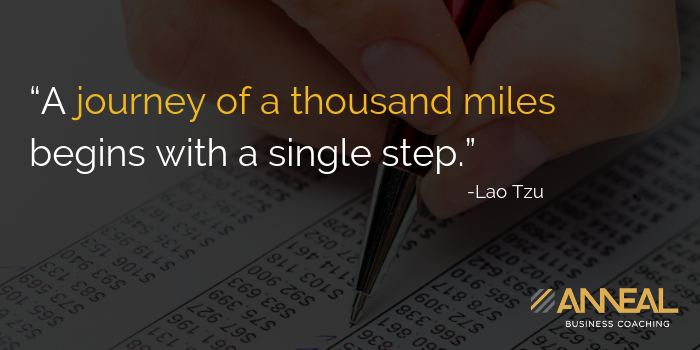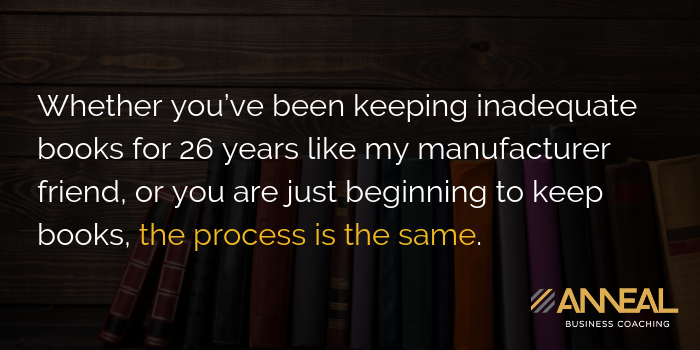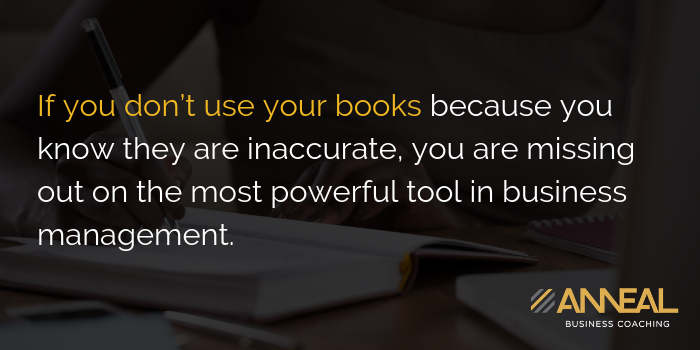6 MIN READ
“A journey of a thousand miles begins with a single step.”
Lao Tzu
“Well, that’s not right.”
The speaker was the owner of a small manufacturing company. We had just opened his aged accounts receivable summary in Quickbooks. Scattered across the columns from “current” through “90 days past due” were a smattering of confusing negative numbers along with some numbers showing money due from customers he was “sure” had paid. There was even a number he pointed to and said: “I’ll never collect that.”
We next opened his balance sheet and started looking at the accounts listed there.
“Do you have $240,000 cash in the bank?” That’s what the balance sheet showed.
“Ha!” he answered, “more like $24,000.”
“How about inventory? Do you have inventory? You’re not showing any on your balance sheet. And what about your credit card balances and accounts payable? Are those numbers right?”
Yes, he had inventory, but no idea how much, and no, the credit card balances didn’t match his credit card statements. He provided an accounts payable number from a spreadsheet on his desk, but it didn’t match the number on the balance sheet. We kept going through the balance sheet accounts with similar results. When we reached the equity accounts he said: “I don’t know what those numbers mean.”
As we talked further, it became apparent that he managed the company by looking at his cash balance online and by relying on Excel spreadsheets that his bookkeeper created to track payments and charges for receivables and payables.
“You know,” I said, “until all of the numbers on your balance sheet are accurate, you have no way of knowing what’s going on in your business, or worse yet what to do about it if you don’t like it. You can’t even know if you’re making money.”
“I understand,” he said, “but it’s frustrating. I’d like to have good books, and I’d like to know how to use them, but I don’t know what to do about it. And besides, I’m too busy to take on another project.”
Does any of that sound familiar?
My previous articles Financial Reports Explained Without Numbers or Math, The Balance Sheet: The Ultimate Scorecard, and 5 Things You Need to Know About Your Income Statement help explain why good books are critical to business decisions. My articles What is Break Even and Why Should We Care?, Where Did My Cash Go?, and How to Build a House for Free provide examples of how to use books to make better decisions and more money. If you are convinced by my articles or otherwise that you need to set up and keep good books, the next step is to actually do it. The problem is that most business owners - at least the ones I talk with - don’t know how to proceed. Well, here’s how: 
Step one is to hire a qualified accountant. Do NOT try to transform or set up your books yourself. It would not be the best use of your time, and you don’t have the knowledge or experience to do it well. (If you did, you would already have good books.) Any good CPA or really good bookkeeper can set up useful books for your company, but be forewarned: most won’t. Although it is not always their fault, I have countless examples of accountants who take on the task but never complete it. You will have to interview accountants to find one who is enthusiastic and committed to helping you.
Step two is to establish a completion date for the project. Without a deadline, bookkeeping projects always seem to mush on indefinitely. It doesn't have to be that way. Set a date, stick to it, and hold everyone involved accountable for getting it done properly and on time.
Step three is to keep up your end of the bargain. This is your project and your priority. The number one reason accountants don’t complete projects on schedule is that business owners do not give them the information they need.
Step four is for the accountant to reconcile your entire balance sheet. Good books always begin with a balance sheet that is correct as of a specific date. In order to produce one, your accountant must reconcile every line on your balance sheet with something: your bank, your credit card statements, accounts receivable invoices, statements from vendors, bills, vehicle loan documents, mortgages, leases, depreciation schedules, prior tax returns and more. Expect to be bombarded constantly by requests for documents and explanations. The bad news is that this can (will) be a tedious and annoying process. The good news is that, once done, you will have accurate, current, and useful information that will be much easier to maintain than it was to compile.
Step five is for the accountant to organize your profit and loss statement. The accountant should separate your Overhead expenses from Cost of Goods Sold expenses so that you can see your margins know your breakeven. He or she will re-classify items such as taxes, car payments and owner draws that are frequently miscatagorized as expenses, and will make bookkeeping entries to best match income with expenses.
Step six is for your bookkeeper to work with the accountant to write processes detailing how and when to make routine bookkeeping entries. At a minimum, you should receive written, step-by-step instructions explaining how to :
- Invoice customers
- Receive payments from customers
- Make bank deposits
- Enter bills
- Pay bills
- Enter and pay credit card charges
- Separate and record interest and principle for loan payments
- Track inventory
- Make inventory adjustments
- Separate overhead expense from cost of goods sold
- Make adjustments to match sales and expenses
- Handle customer prepayment deposits
- Preserve receipts for expenses
- Make monthly depreciation entries
That’s a lot of processes, but once established they quickly become routine.
Step Seven is to set up a process for closing you books each month. Your accountant should “close” your books every month by reconciling all of the accounts on the balance sheet and by checking the profit and loss statement for matching issues and misplaced entries. Closing your books every month ensures that the information you rely on is current and accurate. Closing keeps you current on the condition of your business and protects against embezzlement. Monthly closing also provides a recent benchmark to refer to when looking for future, inevitable bookkeeping errors. 
If you don’t use your books because - like the manufacture above - you know they are inaccurate, you are missing out on the most powerful tool in business management. If you are not convinced, read my articles - and maybe talk to your banker and a successful business peer. If you are convinced, commit and get started. Without you as a dedicated champion, it will never happen.